Q&A – Ask Neil: October 12, 2023
(Please read these instructions carefully.)
Before you post your question, please look at recent issues to see if someone else has already asked it. You might find your answer there.
How to submit your question…
(Note: You may need to allow a pop-up window to come up in order to get the link for sending your photo(s). If you have already submitted your question and didn’t see the pop-up window, please click here.)
• Click the link provided below to post your question. After you submit your question, a new window will pop up giving you the address to which you can e-mail a SHARP, HIGH-RESOLUTION PHOTO to accompany your question. Please DO NOT SEND THUMBNAIL PHOTOS in case I need to zoom in to see things.
• Click here to post your question.
• Please ONLY POST YOUR QUESTION ONE TIME. We can only accept a set number of questions each week, and when we get duplicates it costs other people their chances.
• One question per reader, please.
• Please use this only for posting questions – not for standard emails.
• Watch for your answer in the following week’s e-gardens.
• I choose those of greatest general interest. For example, plant IDs seldom make the cut.
• I must have your first name or initials.
• I must have your city or county. (Texas is a very large state.)
QUESTION 1
IS IT TOO LATE TO PRUNE MY LEGGY ASTERS?
Question: Why are my asters so leggy? Is it the variety? How late can I prune them to get a good fall show? They always bloom beautifully. I just want them more compact. Erin V., Celina.

Answer: I assume you have the same fall aster about which Steve Huddleston wrote in last week’s e-gardens: (https://neilsperry.com/2023/10/fall-for-fall-aster-by-steve-huddleston/) You’ll find some good tips on keeping them more compact. He and I both suggest trimming them back by one-third to one-half in mid-May, much as we do for Mexican bush salvia, to encourage branching. Pruning them any later than that would remove almost all their flower buds for this fall.
QUESTION 2
WHY WOULD MY SHUMARD RED OAK ROT AT THE GROUND?
Question: What would cause my 3-year-old Shumard red oak to rot at the root ball? Lance Q., Ponder.
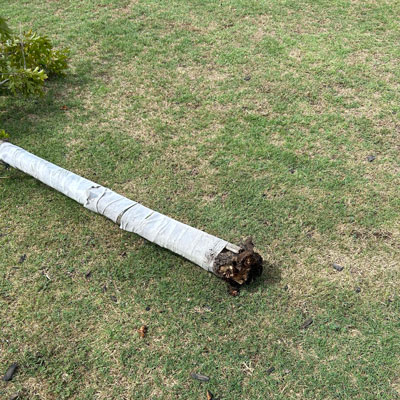
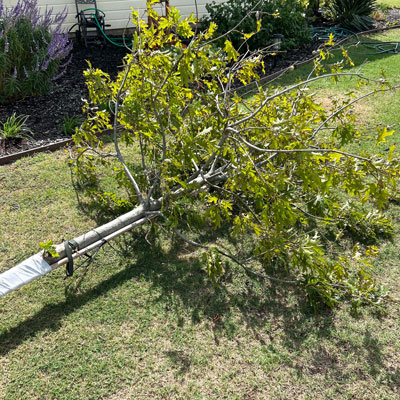
Answer: It’s really hard to tell, but it obviously didn’t happen recently. That wood is badly decayed and the top growth has been declining as evidenced by the dieback of the outer twigs. It could have been caused by a nick from a shovel or hoe, or it might have been some kind of injury caused by a rodent. It happens when a tree is planted slightly too deeply.
QUESTION 3
WHEN IS THE CORRECT TIME TO APPLY PRE-EMERGENT WEEDKILLER?
Question: When is the correct time for pre-emergent? I read where the days need to be 70 degrees for a bit. Is that correct? Audrey H., The Colony.
Answer: You are on the north side of DFW (for the sake of anyone unfamiliar with The Colony). The timing of pre-emergent applications would be between March 5-15 for crabgrass and grassburs (warm-season weeds) in the spring. A repeat application would be needed 90 days later, so June 5-15, to give season-long control. Then, for the cool-season weeds annual bluegrass, rescuegrass and ryegrass, the application should be made September 1-10. Choose any of these: Dimension, Halts or Balan.
I was sitting here trying to figure out who would write that “days need to be 70 degrees” when I realized that probably is referring to that first spring application. That would be as the soil is starting to warm up and seeds are about to start germinating.
QUESTION 4
HOW CAN WE GET OUR EAGLESTON HOLLIES TO THICKEN UP AGAIN?
Question: Our Eagleston hollies have struggled the last two summers due to drought. I tried to water every other day this summer, but they have lost so many leaves. Is there any way to encourage them to grow full and beautiful again? Courtney W., Fort Worth.
Answer: I’ll do my best, but without a photo all I can do is speak generically from my own experiences. When a holly gets too dry just one time, it is very difficult to get it to fill back in again. They may put out new growth, but it’s usually at the tops and outsides. The interior remains empty after the leaf drop caused by the drought. But if anything is going to work it will be nitrogen fertilizer applied with copious amounts of water regularly. It might help to trim them back to encourage thicker new growth.
Also, I need to own something I have said and written many times. Eagleston hollies, being hybrids of American hollies (Ilex opaca) and Dahoon hollies (Ilex cassine) are plants that require acidic soils and acidic irrigation water. We in the Metroplex have neither. I’ve gone on record as saying that in my opinion, Eagleston, East Palatka, and other American holly hybrids should never be sold in our area. At least not for landscapes within the Blackland Prairie. For the 5 percent of Metroplex gardeners who have red sandy clay loam soils in the Mid-Cities, these plants might have a chance. However, the alkaline irrigation water is still not their friend.
QUESTION 5
WOULD IT HELP MY HYBRID BERMUDA LAWN TO HAVE MY LIVE OAK’S CANOPY “LIFTED” AND “THINNED?”
Question: I am worried about my hybrid dwarf (Tif) bermuda. It is very thin due to shade from the live oak. My tree is the photo with the lower canopy. The second photo is how I want my tree. Do you recommend this, or is it too aggressive? Michael G., Mansfield.


Answer: Your home is lovely, and it’s obvious that you’re trying very hard with your lawn and landscape. Good work!
So, you asked my opinions. First, I probably would have planted a live oak just like you did. I had one in our first yard in Farmers Branch in the 1970s. But, in retrospect, live oaks need really large yards because their eventual “wing spans” can be 60 or 70 feet. No tree that we grow gets any wider.
The reason I bring that up is because “lifting and thinning” may only buy you a few years before you’ll have shade issues once again. There will come a time when you would disfigure the tree if you cut horizontal growth off the tree as well as removing lower branches.
That’s why I encourage people at least to consider a shade-tolerant groundcover beneath their live oaks. They can look beautiful and just as tailored as a lovely lawn, but actually without as much work once they’re established. HOAs aren’t always sympathetic, but that’s because they’re not always administered by people who understand how difficult it is to get the necessary 7 or 8 hours of direct sunlight to bermuda beneath shade trees.
On my first glance at your “lifted” photo I didn’t think that it was very attractive, but as I enlarged it and cropped it for publication, I could see how well the arborists had done their work. If that’s a look you want to achieve, I wouldn’t fault you, but I fear that it won’t hold for very long. Look around town at unpruned mature live oaks and you’ll see what I mean. They spread far and wide. My choice would be to switch over to a simple planting of groundcover like mondograss or liriope.
I hope my ramble has been of some help somehow.
QUESTION 6
WHAT WINDBREAK IS BETTER THAN THUJAS?
Question: The back of my property faces southwest. I want to grow a windbreak there (120 ft. long). Is there a tree or large shrub to 20-30 ft. tall that I can grow there that will be more heat tolerant than the thujas I planted earlier? They all died. Byron B., Forney.
Answer: I am so sorry you had that experience. Those plants are beautiful and tantalizing in the big box stores, but they won’t handle our temperatures and low humidity. They need the Pacific Northwest.
Stay away from Leyland cypress because of disease issues.
Your ideal plant would be native eastern redcedar junipers (Juniperus virginiana). You see it growing on hillsides all over North Central Texas. Its mature height is 30-35 ft. Space the plants 20-22 ft. apart. I would suggest not planting them in a straight row, but rather in staggered clusters for a more natural look. Plant them during winter, and plan on watering them by hand every few days for their first couple of summers.
All of that said, are you really sure you want a “windbreak” on the south side of your house? That’s the direction where prevailing winds come from in summer. Stopping those breezes could make for a hot, still atmosphere around your house. Normally windbreaks are called on to stop the flow of cold north winds in winter. If it’s privacy you’re seeking, it’s all the more important that you stagger your plantings to allow passage of air onto your property while still breaking the lines of sight.
QUESTION 7
WHY IS MY PALISADES ZOYSIA DEVELOPING YELLOW SPOTS IN LATE SUMMER?
Question: My Palisades zoysia lawn has developed yellow patches each of the past two summers. Is that iron deficiency? Allen, Fort Worth.
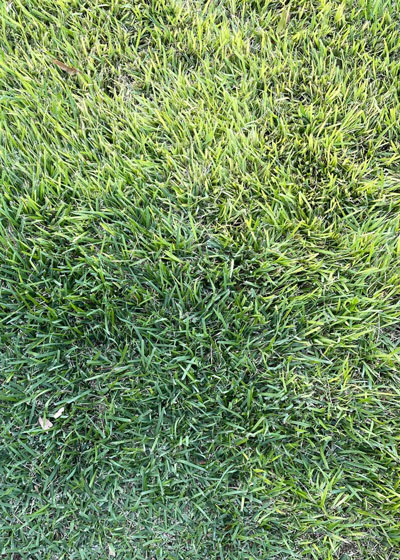

Answer: (Allen spoke with me on KLIF this past Saturday afternoon. I realized I couldn’t go any farther without seeing photos of his zoysia lawn. He provided them to me, and here are my thoughts.)
I was ready to throw in the towel and admit that it does look like iron chlorosis after looking at your closer photos. The striping of the leaves is visible, although not as obvious as one would see with St. Augustine.
I had already written the suggestion that you pull soil samples from several spots in the yellowed areas to see if those samples might have rock or other debris that would be limiting their retention of nutrients. Failing at that, then you could send the sample to the Texas A&M Soil Testing Lab to have it tested for basic N-P-K nutrients (or lack thereof) and pH (acidity/alkalinity). I wondered if the builder might have pulled debris up into those areas and if that debris might have been highly alkaline.
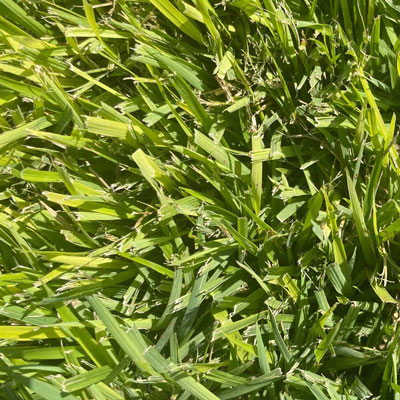
And then you sent the more distant photos. They suggest that this is not a brand new neighborhood, so it’s unlikely that it’s debris from the builder at fault. Honestly, those more distant photos look very much like a fungal leaf disease. St. Augustine with gray leaf spot looks just like that, for example. The only problem is that I didn’t find much evidence of gray leaf spot bothering zoysia online, and I don’t see spots on the blades in your close-ups. What I do see are badly frayed leaf tips. The mower blades need to be sharpened. However, I don’t think that’s associated with the yellowing.

Still, I think this looks more fungal than anything. I’d suggest sending photos and actual turfgrass samples to the Texas A&M Plant Disease Diagnostics Lab in College Station. They do charge to culture the samples, but owing to the value of your sod, that’s a small price to pay to get the right answer.
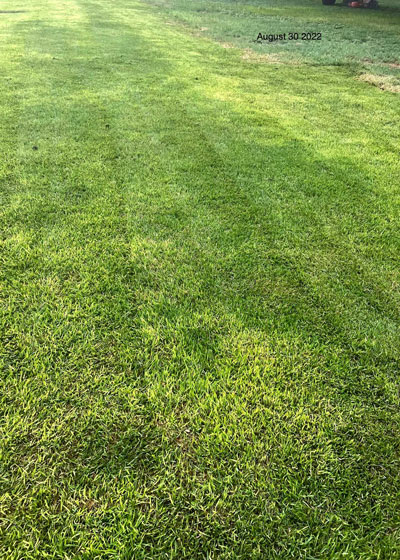

I’d be very interested in finding out what they report back. Good luck. (If it’s any consolation, I spent about an hour trying to get an answer for you!)
QUESTION 8
WHY IS MY ‘LITTLE MISS FIGGY’ FIG GROWING SO TALL?
Question: I’ve had two Little Miss Figgy dwarf fig plants for four years. I left them outside last winter. In spring one came out perfectly, but the other died to the ground. Eventually new shoots came up from below ground, but one has grown very tall. The side branches also grew out, but there were no fruit on any of the limbs. What should we do with the larger plant? Elda M., Flint (Lake Palestine).
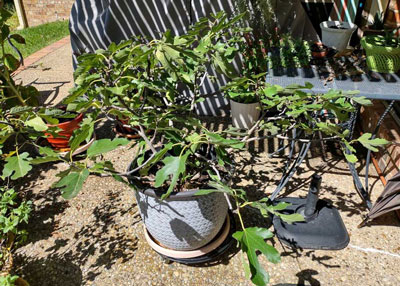

Answer: I have not grown this cultivar, so I did some Internet research. As I often do, I clicked into the website of the Missouri Botanical Gardens. Here’s what they had to offer:
‘MAJOAM’, sold under the trade name of LITTLE MISS FIGGY, was discovered by Michael Nobles in September 2010. It was growing as a naturally occurring branch mutation of Ficus ‘Violette de Bordeaux’ in a container at his nursery in Ridgeville, South Carolina.
Next, I spent some time online trying to see if this vigorous shoot development has been reported. I only found a couple of references from people on a gardening blog reporting that their “Little” Miss Figgy had grown into a “Big” Miss Figgy 6 or 8 ft. tall. That made me wonder if it might have mutated back to its origin ‘Violette de Bordeaux’ mother plant.
Now, completely over my head, I wrote to Dr. Larry Stein, longtime friend and Associate Department Head for Extension Programs (Horticulture). If anyone would know, I knew Larry would. Here is what he wrote back:
“I would have the lady check the prolific Miss Figgy plant right at the place where the strong shoot emerges as compared to the other shoot. The one shoot looks normal and indeed the other looks to have mutated back to original. It is almost like a grafted plant that roots in and loses the effect of the dwarfing rootstock. It is not uncommon for plants to do this. I would suggest that the dwarf mutation is not 100% stable and hence the strong shoot. I would have her remove the strong shoot completely and see what happens.”
Larry and I both feel the plants need to be repotted into larger containers.
QUESTION 9
WHY WOULD MY TWO APPLE TREES THAT HAD HUNDREDS OF APPLES IN 2021 HAVE NONE IN 2022 AND ONLY FOUR IN 2023?
Question: I have two apple trees (one a Granny Smith and the other a red variety, but I don’t remember which). They are 7 or 8 years old. In spring 2021 they had several hundred apples. In 2022 absolutely no apples. In 2023 they had just four apples. They bloom at the same time, and I’ve seen many bees but no small fruit after they finish flowering. What can I try to get fruit again? Richard, Hudson Oaks.
Answer: Richard called my radio program as well, and I also asked Dr. Stein for his suggestions since he is one of A&M’s foremost experts on apples. Here was his reply:
“The apple question has no easy answer as you well know. A few possibilities come to mind though. This is a long shot, but I will lead with it, is that he might have sprayed a product containing “Sevin” (carbaryl) insecticide after the trees had bloomed. This is used to thin apples commercially. I really doubt this happened but did want to mention it.
“Another thought is that there was a late frost in 2023, as we did have one in this area (Uvalde). He did not say, but perhaps the bloom was not very strong in 2023, which could be a fertility issue. Again, does not seem plausible because of no crop in 2022, which typically means a strong bloom the next year. Lastly, if the bloom was strong in 2023 and bee activity was good, it may be that the area experienced high heat and drying winds during bloom. Such events drastically affect pollen viability. If the trees are healthy, I would suggest that he make sure they are well watered going into the winter and expect a prosperous 2024.”
Good information from Dr. Stein – Thanks, Larry!
